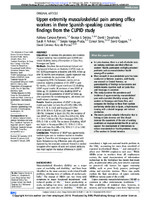Mostrar el registro sencillo del ítem
Upper extremity musculoskeletal pain among office workers in three Spanish-speaking countries: findings from the CUPID study
| dc.contributor.author | Campos-Fumero, Adriana | |
| dc.contributor.author | Delclos, George | |
| dc.contributor.author | Douphrate, David | |
| dc.contributor.author | Felknor, Sarah | |
| dc.contributor.author | Vargas-Prada, Sergio | |
| dc.contributor.author | Serra, Consol | |
| dc.contributor.author | Coggon, David | |
| dc.contributor.author | Ruiz-De Porras, David Gimeno | |
| dc.date.accessioned | 2018-08-10T14:35:11Z | |
| dc.date.available | 2018-08-10T14:35:11Z | |
| dc.date.issued | 2016 | |
| dc.identifier | https://www.scopus.com/inward/record.uri?eid=2-s2.0-84959273920&doi=10.1136%2foemed-2015-103327&partnerID=40&md5=8b801e2108ff856ee3333f2cee3736c7 | es |
| dc.identifier.citation | Campos-Fumero, A., Delclos, G., Douphrate, D., Felknor, S., Vargas-Prada, S., Serra, C., Coggon, D., & Ruiz-De Porras, D. (2016). Upper extremity musculoskeletal pain among office workers in three Spanish-speaking countries: findings from the CUPID study. Occupational and Environmental Medicine, 73(6), 1-7. | es |
| dc.identifier.issn | 13510711 | |
| dc.identifier.uri | https://hdl.handle.net/2238/9894 | |
| dc.description | Artículo científico | es |
| dc.description.abstract | Objectives To estimate the prevalence and incidence of upper extremity musculoskeletal pain (UEMP) and related disability among office workers in Costa Rica, Nicaragua and Spain. Methods Data from the multinational Cultural and Psychosocial Influences on Disability (CUPID) study on 947 (93%) participants at baseline with 90% follow-up after 12 months were employed. Logistic regression was used to estimate the associations (ORs and corresponding 95% CIs) between country and six outcomes: baseline prevalence of (1) UEMP in past 12 months, (2) UEMP in past month and (3) disabling UEMP in past month; (4) incidence of new UEMP at follow-up; (5) incidence of new disabling UEMP at follow-up and (6) persistence of UEMP at follow-up, after adjustment for sociodemographic, job-related and health-related covariates. Results Baseline prevalence of UEMP in the past month was higher in Costa Rica (53.6%) (OR=1.89; 95% CI 1.36 to 2.62) and Nicaragua (51.9%) (OR=1.74; 95% CI 1.28 to 2.35) than in Spain (38.4%). Compared to Spain (33.2%), the incidence of new UEMP was 50.4% in Costa Rica (OR=2.04; 95% CI 1.34 to 3.12) and 60.2% in Nicaragua (OR=3.04; 95% CI 2.06 to 4.50). The incidence of disabling UEMP was higher in Nicaragua (OR=2.57; 95% CI 1.50 to 4.41) and Costa Rica (OR=2.16; 95% CI 1.22 to 3.84) when compared to Spain. Conclusions Prevalence of UEMP was approximately twofold higher and its incidence twofold to threefold higher in Costa Rica and Nicaragua as compared with Spain. Between-country differences were only partially explained by the covariates analysed. Research is needed to explore other aspects of work and cultural attributes that might explain the residual differences in UEMP. | es |
| dc.language.iso | eng | es |
| dc.publisher | Occupational and Environmental Medicine | es |
| dc.relation.hasversion | 10.1136/oemed-2015-103327 | es |
| dc.rights | acceso abierto | es |
| dc.source | Occupational and Environmental Medicine | es |
| dc.subject | Discapacidad | es |
| dc.subject | Salud | es |
| dc.subject | Músculos | es |
| dc.subject | Relaciones laborales | es |
| dc.subject | Condiciones de trabajo | es |
| dc.subject | Research Subject Categories::MEDICINE::Social medicine::Public health medicine research areas::Occupational medicine | es |
| dc.title | Upper extremity musculoskeletal pain among office workers in three Spanish-speaking countries: findings from the CUPID study | es |
| dc.type | artículo original | es |
Ficheros en el ítem
Este ítem aparece en la(s) siguiente(s) colección(ones)
-
Artículos [29]
Artículos en otras revistas


